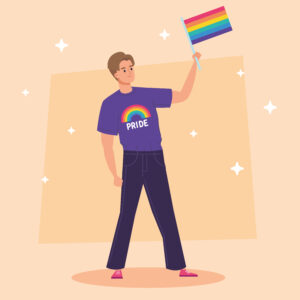
On June 6, Los Angeles (LA) officials held a flag raising ceremony to fly the Progress Pride Flag at city hall. After nearly 243 years, this was the first time in the city’s history that a pride flag was flown at a municipal building. The flag raising ceremony is another progressive step forward for a city that has a strong relationship and history with the LGBTQ+ community, as the first permitted gay pride parade in the world was held on Hollywood Boulevard in 1970. However, LA’s dedication to continuing this positive relationship with the LGBTQ+ community isn’t as common as it should be in California.
The decision to host this event comes during a crucial time for the LGBTQ+ community as multiple municipalities in California are stepping back from inclusivity and voting to ban pride flags for pride month celebrations. For example, Huntington Beach city officials voted last March to approve a ban on “nongovernmental flags” being flown on city property and Downey approved a new “neutral flag policy” in May. These bans are a shameless attempt to prevent pride flags from being flown on official buildings.
Additionally, the Temecula school district voted last September to approve a ban on all flags — except the U.S. and California state flags — on school campuses. The school board claimed that the ban was not put in place to single out pride flags, but the arguments made in favor of the ban targeted pride flags specifically. One student’s mother and supporter of the flag ban said she was upset that she “had to go to her child’s school and see a rainbow flag hung on a wall.” Another woman claimed that children would become curious and want to “try out” being gay, explicitly mentioning her concern about pride flags.
Decisions like this result in making the community feel unwelcome and unsafe, many in their home towns and schools, because these decisions put a “target on the backs of young queer people in their community.”
The pride flags, especially the inclusive Progress Pride Flag, are important because they show solidarity and support for people who are part of the LGBTQ+ community. Banning the flags outright clearly shows that the community does not support the LGBTQ+ community and wants to ignore the existence of queer people altogether. Most importantly, banning pride flags sends the message that the LGBTQ+ community should hide a crucial part of their identity in these spaces, making people feel unwanted and, in most scenarios, unsafe.
LA County officials worked towards the opposite this pride month by creating a safe and nurturing environment for the LGBTQ+ community to celebrate how far they have come, and bring to light how far they still need to go. By raising the flag at city hall ahead of the annual LA Pride Parade, they send the message that LA County officials stand with the LGBTQ+ community and will support and work alongside them. The ongoing effort to stop discriminatory laws and bans will continue until queer people in California communities are safe. Even with Pride Month ending soon, there is much left to do to create a space that accepts and protects the LGBTQ+ community.







